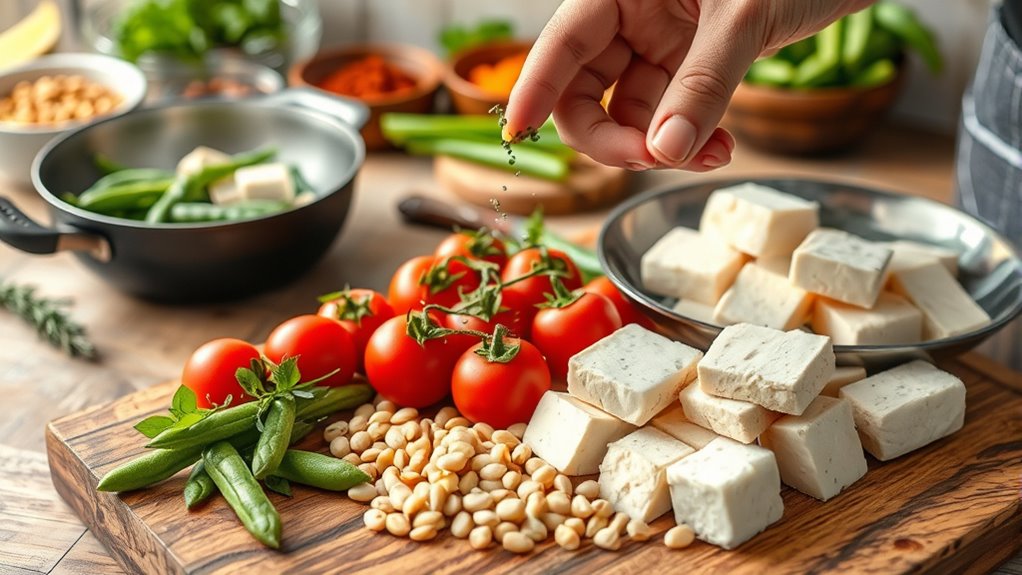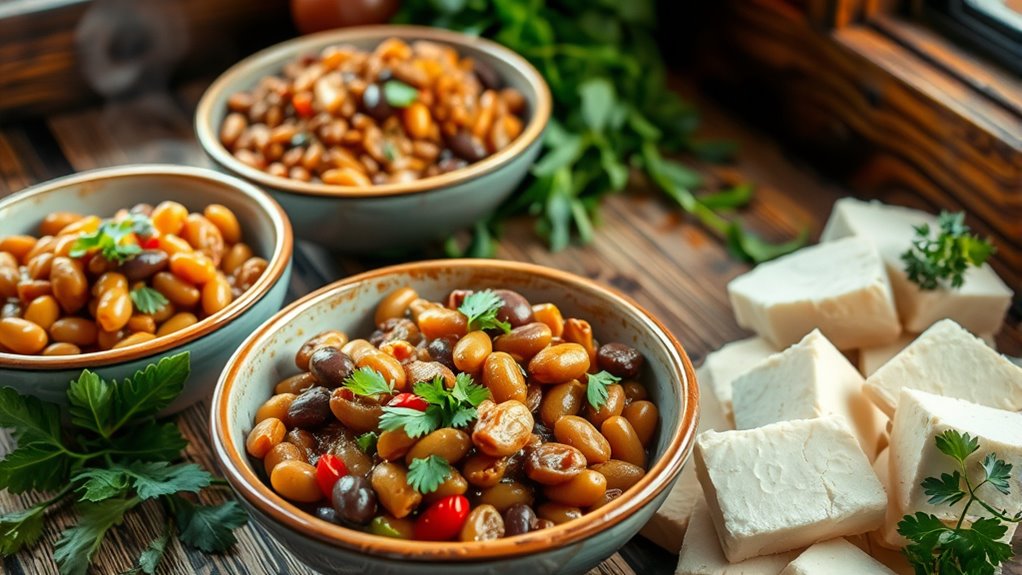To cook with beans, lentils, and tofu, start by preparing them properly—soak and rinse beans, cook lentils quickly, and press tofu to remove excess moisture. Use flavorful seasonings like cumin, garlic, soy sauce, or turmeric to enhance their taste. Mix and match with diverse ingredients and spices to create tasty dishes. Keep exploring these techniques to master versatile, plant-based meals that fit your busy lifestyle.
Key Takeaways
- Soak beans overnight and rinse before cooking to improve digestibility and reduce cooking time.
- Use slow-cooking or pressure-cooking methods to achieve tender beans and lentils quickly and efficiently.
- Marinate tofu in soy sauce, sesame oil, and ginger to enhance flavor before pan-frying or baking.
- Cook lentils based on their type: red/yellow for soups, green/brown for salads, adjusting cooking times accordingly.
- Experiment with seasonings like cumin, garlic, turmeric, and chili powder to create flavorful, versatile plant-based dishes.

Plant-based proteins have become increasingly popular as more people look for healthy, sustainable, and ethical alternatives to animal products. If you’re exploring ways to incorporate beans, lentils, and tofu into your diet, you’ll find they’re versatile ingredients that can transform your meals. One effective approach is meal prep, which allows you to cook large batches ahead of time, saving you effort during busy weekdays. By preparing these proteins in advance, you can quickly assemble a variety of dishes, reducing mealtime stress and ensuring you always have nourishing options ready to go.
Meal prepping with beans, lentils, and tofu makes healthy, flavorful plant-based meals easy and stress-free.
When it comes to cooking with beans, lentils, and tofu, experimenting with flavor combinations is key. For example, you might combine black beans with cumin, chili powder, and lime for a zesty taco filling, or toss lentils with garlic, turmeric, and coconut milk to create a creamy, comforting stew. Tofu, on the other hand, lends itself well to a wide range of flavors. Marinate it in soy sauce, sesame oil, and ginger before pan-frying or baking, and you’ll get a savory, crispy addition to stir-fries or grain bowls. The beauty of these plant proteins is their ability to absorb flavors, making them adaptable to various cuisines and seasoning profiles.
To maximize taste and texture, learn how to prepare and season these ingredients properly. For beans, soaking and rinsing can remove excess sodium and improve digestibility, while slow-cooking or pressure-cooking ensures they’re tender. Lentils cook quickly; red and yellow varieties are perfect for soups and purees, while green and brown lentils hold their shape better in salads and stews. Tofu’s texture can be altered by pressing out excess moisture before cooking, which helps it absorb marinades more effectively and develop a satisfying crispiness when pan-fried or baked. Additionally, the use of traditional techniques such as canning and preservation can extend the shelf life of these ingredients and make meal planning even easier.
Incorporating these proteins into your meal prep routines not only boosts your nutritional intake but also encourages creative flavor pairing. Think beyond traditional combinations—try blending spicy, sweet, and savory elements to keep your taste buds engaged. For instance, a lentil salad with roasted sweet potatoes, feta, and a tangy vinaigrette, or a tofu scramble with turmeric, peppers, and onions. These dishes are simple to assemble after cooking, and by experimenting with different seasonings and sauces, you’ll discover endless flavor combinations that keep your meals exciting and satisfying. With a little planning and creativity, plant-based proteins can become the cornerstone of delicious, wholesome meals you’ll look forward to every day.
Frequently Asked Questions
How Do I Store Cooked Beans and Lentils Properly?
To store cooked beans and lentils properly, follow these storage tips. First, let them cool completely before transferring to airtight containers. Keep them in the refrigerator for up to 4-5 days, or freeze for longer shelf life—up to 6 months. Label containers with dates to track freshness. Proper storage prevents spoilage and maintains quality, ensuring you enjoy your plant-based proteins safely and conveniently whenever you need them.
Can Tofu Be Used in Sweet Desserts?
Think of tofu as a blank canvas, ready to absorb the sweet whispers of your dessert ideas. Yes, you can turn tofu into a luscious component of sweet tofu recipes, creating delightful tofu dessert ideas that surprise and delight. From silky puddings to creamy mousses, tofu’s versatility shines in desserts. Experiment with flavors, add fruits or sweeteners, and enjoy crafting a unique, healthful treat that elevates your sweet repertoire.
Are There Seasonal Variations in Bean and Lentil Availability?
You’ll notice seasonal variations in bean and lentil availability due to regional harvest times. During peak seasons, you get fresh, locally-grown varieties, which often taste better and are more affordable. Off-season, you might rely on dried or imported options. To make the most, plan your cooking around regional harvest cycles, and explore different varieties that are in season. This way, you enjoy the best flavors and support local agriculture.
How Do I Improve the Flavor of Plain Tofu?
Did you know that marinating tofu for at least 30 minutes can boost its flavor considerably? To improve the taste of plain tofu, try seasoning tofu with spices, soy sauce, or your favorite marinade. Marinating tofu allows flavors to seep in, making it more delicious. Also, pressing tofu before cooking helps remove excess water, so seasonings stick better. Experiment with different marinades to find your perfect flavor profile!
Which Plant-Based Proteins Are Best for High-Protein Diets?
If you’re aiming for high-protein diets, focus on legume varieties like lentils, chickpeas, and black beans, which boast impressive protein content. These plant-based proteins are versatile and nutrient-dense, making them excellent choices. Incorporate them into your meals by adding to salads, stews, or making spreads. Their high protein content helps meet your dietary needs while supporting muscle growth and overall health.
Conclusion
Now that you’ve explored the vibrant world of plant-based proteins, imagine your plate bursting with colorful beans, tender lentils, and silky tofu, all seasoned perfectly. With each bite, you’re not just nourishing your body but also painting a picture of sustainability and flavor in every meal. So, grab your favorite ingredients, get creative, and turn simple plant proteins into delicious, hearty dishes that fuel your day and delight your senses. Your plant-powered journey starts now.









